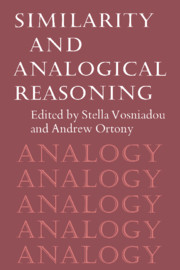Book contents
- Frontmatter
- Contents
- Preface
- List of contributors
- Similarity and analogical reasoning: a synthesis
- Part I Similarity and the structure of concepts
- Part II Analogical reasoning
- Part III Similarity and analogy in development, learning, and instruction
- 14 Analogical learning and transfer: What develops?
- 15 Analogical reasoning as a mechanism in knowledge acquisition: a developmental perspective
- 16 Remindings in learning and instruction
- 17 New approaches to instruction: because wisdom can't be told
- 18 Multiple analogies for complex concepts: antidotes for analogy-induced misconception in advanced knowledge acquisition
- 19 Comments on Part III: The activation and acquisition of knowledge
- Afterword: Comments on Parts I, II, and III: A framework for a theory of comparison and mapping
- Name index
- Subject index
19 - Comments on Part III: The activation and acquisition of knowledge
Published online by Cambridge University Press: 22 October 2009
- Frontmatter
- Contents
- Preface
- List of contributors
- Similarity and analogical reasoning: a synthesis
- Part I Similarity and the structure of concepts
- Part II Analogical reasoning
- Part III Similarity and analogy in development, learning, and instruction
- 14 Analogical learning and transfer: What develops?
- 15 Analogical reasoning as a mechanism in knowledge acquisition: a developmental perspective
- 16 Remindings in learning and instruction
- 17 New approaches to instruction: because wisdom can't be told
- 18 Multiple analogies for complex concepts: antidotes for analogy-induced misconception in advanced knowledge acquisition
- 19 Comments on Part III: The activation and acquisition of knowledge
- Afterword: Comments on Parts I, II, and III: A framework for a theory of comparison and mapping
- Name index
- Subject index
Summary
Introduction
This chapter discusses the issues of similarity and analogy in development, learning, and instruction as represented in the chapters by John Bransford, Jeffery Franks, Nancy Vye, and Robert Sherwood; Ann Brown; Brian Ross; Rand Spiro, Paul Feltovich, Richard Coulson, and Daniel Anderson; and Stella Vosniadou. The following anecdote illustrates many of the themes that appear in the discussion of these chapters.
I was in a seminar recently where we were trying to set up an overhead projector for the first time. There was no screen in the room, and the one patch of wall of reasonable size was crossed with pipes. So I said to one of the other faculty members, “Let's try aiming the projector at the blackboard.” This individual said, “No, that's crazy.” I immediately gave in and began helping to aim the projector toward the wall. Then I said, “Wait, let's try the blackboard – I think it will work”. We did try the blackboard, and it did work reasonably well.
What was going on here? First, why did the other person immediately reject my original suggestion, and why did I give in? I think it is clear that the other person had a causal model for light which included the assumption that black surfaces absorb all the light that falls on them. As applied to the example at hand, this meant that it would be stupid to try to project the overhead on the blackboard, since no light would reflect off it and we would not be able to see the transparencies.
- Type
- Chapter
- Information
- Similarity and Analogical Reasoning , pp. 532 - 545Publisher: Cambridge University PressPrint publication year: 1989
- 2
- Cited by



